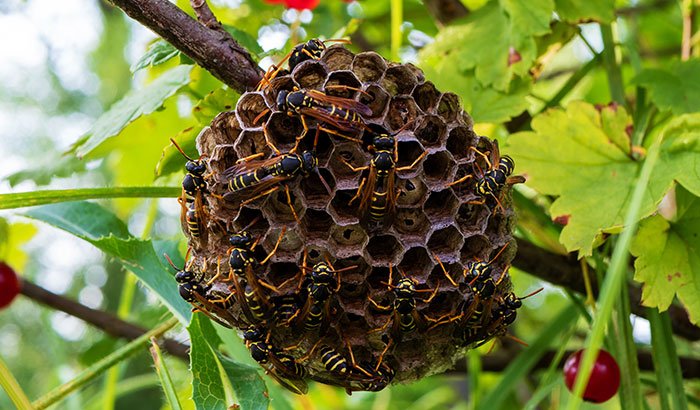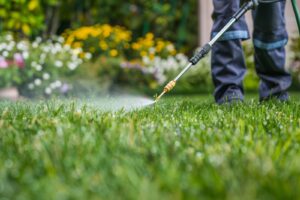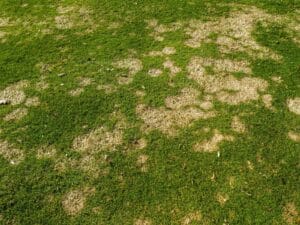A single hornet makes most people nervous, so the thought of a full-blown infestation is overwhelming– especially if the hornets are in your house.
If you live in an area where bees are present, you might be wondering, “What are hornets?”, “Are they dangerous?”, and “How do I get rid of them?” Out of all insects, hornets probably have the worst reputation in terms of their ability to deliver a painful sting.
If you see one hornet, you already know that the best plan of action is to slowly walk away, but what happens if you start spotting them all around your home?
If you see a hornet or its nest in or around your home, it’s crucial to act fast. Here are some tips for handling hornets when they threaten to invade your home.
What Are Hornets?
When contemplating, “What are hornets?”, most people are unaware of their relation to wasps. Hornets are wasps with smooth bodies, wings, and six legs. In the United States, there are two main types– the European hornet and the bald-faced hornet.
The European hornet measures 1 to 1.5 inches in length, has a reddish-brown body with yellow rings around the back end, and a yellow face. These hornets build their nests at least six feet above the ground and are active both at night and during the day.
The bald-faced hornet is a smaller species with whitish circles around the eyes. Their nests measure up to two feet long and are made of a paper-mache-like substance.
Hornets in the House
Hornets are small enough to enter your home when you least expect it. Once inside, they can easily get comfortable and start marking their territory with a nest. If you notice hornets in your house or around the perimeter, it’s time to locate their territory.
Here are some common places to search for a hornet’s nest:
- Attics – Hornets love to hibernate in attics throughout the winter. These rarely used, gloomy corners provide wasps with a secure place to land.
- Basements – Basements offer another haven for hornets to hide. Downstairs, there are numerous dim corners where a hornet nest might be constructed.
- Doors and windows – Open doors and windows are one of the most common ways that hornets might enter your house. A pleasant day could bring a refreshing wind, but it might also attract hornets searching for a spot to nest. Check the corners of windowpanes and doors for potential nests.
- Bathroom or laundry exhaust vents – Any opening in a bathroom or laundry room exhaust vent that leads outside is a hornet’s nest waiting to happen.
- Garages – When looking for a site to call home, hornets often find the shadowy interiors of garages to be attractive. The garage offers an excellent hibernation station for the queen.
Dealing with the problem as soon as it emerges is the best approach to removing wasps from your home. The issue will only get worse the longer you allow these insects to feel comfortable.
Steps To Eradicate
Finding hornets in your house or lurking outside isn’t a joyous occasion. If you’re in need of eradication, here are the steps you should take:
- Identify the nest – First, search for hornet activity and potential nesting locations all around your yard and inside your house. Most of the time, hornet nests are discovered in protected areas like attics, roofs, under leafy trees, or on windows. Keep an eye out for any obvious nests and active hornets.
If you see a hornet in flight, watch where it travels– eventually, it will show you where it’s nesting. It’s hard to miss a hornet’s nest– it’s shaped like a football and can be found hanging freely or fastened to a larger structure.
- Spray the nest – Ideally, spraying should take place at night when the hornets are “at home” and less active. Adorn protective clothing, such as long pants, a long-sleeved shirt, socks, gloves, and goggles. To achieve the best results, adhere to the label’s instructions. Check again in a few hours and spray again if needed.
- Remove the nest – Using a stick or broom, move the nest from its site once there is no longer any hornet activity. Preferably, transfer it straight into a garbage bag. Dispose of the nest properly to avoid endangering the well-being of other beneficial insects. Exercise caution since it’s soaked in insecticide.
Are Hornets Dangerous?
Hornets can give a painful sting when they detect threats close to their nests. Tormented hornets might also shoot venom into an adversary’s eyes to temporarily blind them. Although they rarely inflict long-term harm, their stings can be extremely painful, and those who are allergic to their venom may experience life-threatening medical complications.
Side Effects of a Sting
Aside from the obvious pain, here are some common side effects of a hornet sting:
- a raised, reddish area where the sting occurred
- warmth near the sting
- pulsing pain near the sting
- itching
- bleeding
- possible hives near the sting
First Aid
According to the CDC, here are the steps you should take if experience a hornet sting:
- Have someone stay with the affected person to ensure that they don’t experience an allergic reaction
- Use soap and water to clean the area
- Remove the stinger with gauze or by scraping the area with your fingernail
- Never use tweezers or squeeze the stinger
- To reduce swelling, apply ice
- Scratching the sting will increase swelling, itching, and the risk of infection
Let Summit Lawn and Pest Control Stop Your Hornet Problem
If hornets are wreaking havoc on your property this fall, the professionals at Summit Lawn & Pest Control are here to help! Whether you’re in need of a pest exterminator or lawn services in Orem or the Utah County area, our highly qualified technicians have the experience needed to help solve your problem.Contact us today to learn more and to set up your free consultation! We serve Utah County, Utah cities such as Lehi, American Fork, Orem, Eagle Mountain, Spanish Fork, and others!







